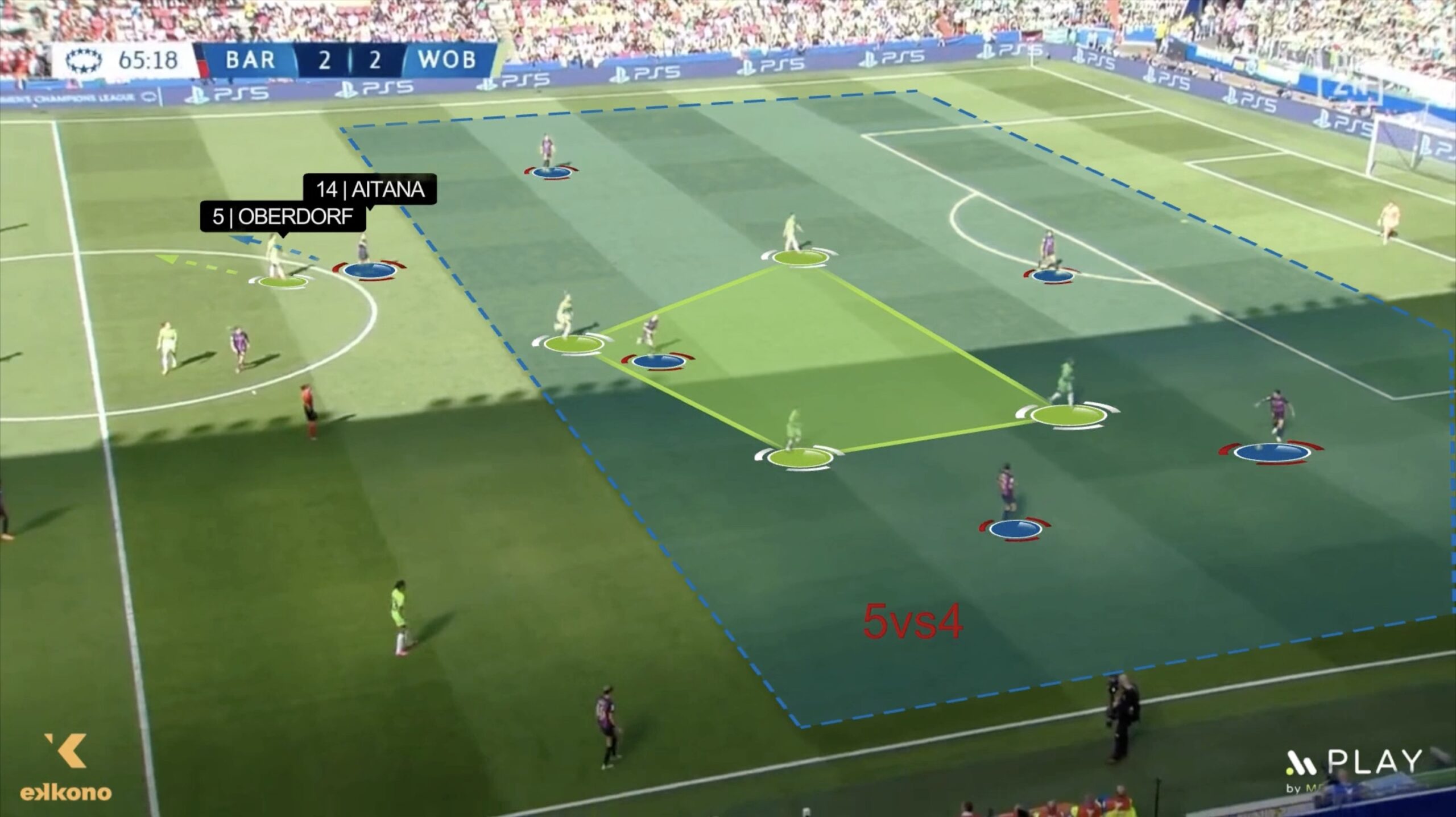
FC Barcelona Femení have won their second UEFA Women’s Champions League after beating VfL Wolfsburg (3-2) in the final played in Eindhoven. Before the game, it was expected that Barcelona would take the initiative of the game, while Wolfsburg would defend compactly and took advantage of the counterattacks. We’ve analyzed what happened in the game, how Wolfsburg managed to put Barcelona in serious problems (they were leading 0-2 at half time), and how Barcelona could revert the situation in the second half. This proves the importance of tactical adjustments during matches.
How did Wolfsburg approach the match in defense?
Wolfsburg was structured in a 4-1-4-1, with Popp (ST) taking care of pressing the Paredes (CB) and Mapi León (CB). making it difficult for Barcelona to build-up from the back. Also, the midfielders were marking individually and the central backs being very aggressive chasing Mariona (ST) to prevent her from generating superiority. This defensive structure did not allow Barcelona find open players in the build-up during the first half, and prevented them from arriving to the final third with advantage.
How did Barça attack?
One of Barcelona’s ideas was to generate numerical superiority in the central area with the support of the striker, Mariona. However, Wolfsburg’s centre-backs limited this action, as she could not receive turn and face Wolfsburg’s last line, so the only viable option was to play back.
Barça also tried to generate superiority through driving the ball by Mapi León (CB), either to create superiority on the flanks (3 vs 2) or to attack the back of Wolfsburg defensive lines with the runs made by Rolfö (LB). Mapi León also helped create advantage by changing the game orientation with diagonal passes to Hansen (W), looking for the one-versus-one duel against Rauch, Wolfsburg left back.
What changed in the second half?
Barcelona was trailing 0-2 at half time, so coach Jonatan Giráldez had to look for solutions. Despite not making any substitutions, Barcelona started the second half with was an exchange of positions between Mariona who was playing as a striker and Salma Paralluelo who was playing as a left winger. From the wing, Mariona managed to receive more times with advantage and with the proper body orientation, since the supports were not starting from a vertical position from Barcelona’s midfielders. Paralluelo, with different characteristics than Mariona, was in charge of pining the power stations more, preventing them from jumping forward to defend.
In addition, another change was that Aitana Bonmatí (AM) did not get so close to the ball, during the build-up. As Wolfsburg was keeping individual marking in the midfielders’ zone, this caused Lena Oberdorf (M) to also stay and move away from the ball zone. In the first half, Oberdorf was creating problems to Barcelona’s build-up difficult, so this movement helped created a GK+5 vs 4 for Barcelona and build up with advantage from the back.
Once achieved this first advantage, Barcelona was able to progress by driving the ball or by filtering progressive passes to the next line, that also had the advantage of Mariona playing from the wing and moving to inner areas, to receive the ball.
Conclusion
Both teams kept their game plan throughout the whole final, but the adjustments that Giráldez made for Barcelona at half time – adjusting Mariona and Aitana’s positioning, helped the team overcome Wolfsburg aggressive mid-block and find advantages to create chances and come back to end up winning their second UEFA Women’s Champions League. As coaches, we need to be able to read the games and make adjustments during the game or at half time, to overcome the difficulties that the opponent is creating. This proves the importance of tactical adjustments during matches. We must highlight, though, that it is not necessary to change your attacking style, but to perfect it or generate variants to hinder the opponent’s plan.
Finally, even though it is not mentioned in this analysis, both goals from Barcelona came from crossing situations. If you are interested in knowing more about the principles that Giráldez’s side applied, you can rewatch our webinar on this topic here.

